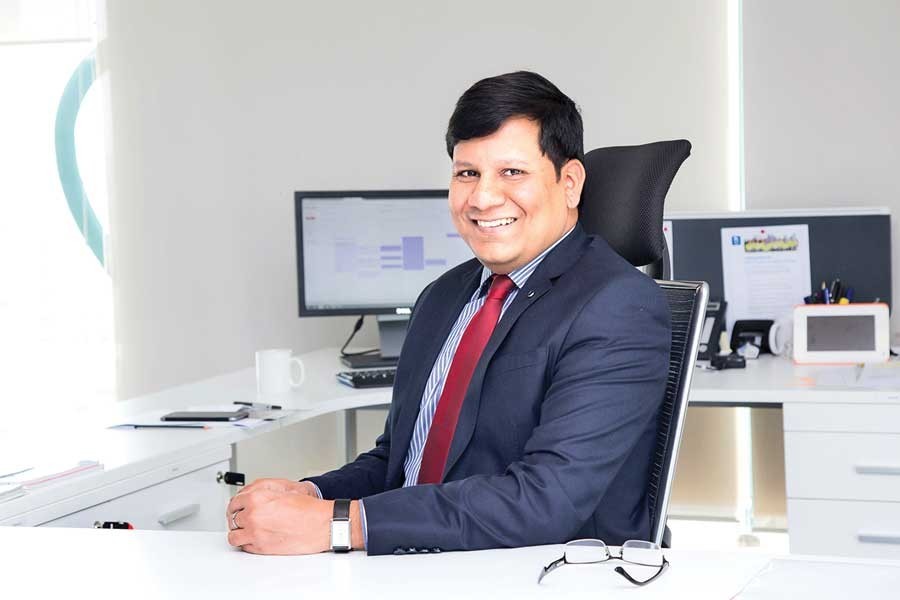
Published :
Updated :

LafargeHolcim Bangladesh vows to become the most sustainable and trusted building material solutions and service provider in the country.
"The global cement manufacturer will be an effective partner in the nation building exercise by providing high quality products to the market as cement is a core ingredient for implementing the ongoing mega development projects in Bangladesh," CEO of LafargeHolcim Bangladesh Limited Rajesh Surana told the FE in an interview.
As LafargeHolcim Bangladesh has successfully completed its amalgamation with Holcim Cement (Bangladesh) Limited last year, he said the company is now working to transform the integrated company as a building material solutions provider from a cement manufacturer company.
"The integration of two most premium and globally reputed companies has lots of synergies and benefits, so it plans to build on strengths of both the companies and provide the customers with multiple products and solutions under one umbrella rather than being a mere cement manufacturer," Mr Rajesh Surana said.
He said they are working on creating sustainable solutions by understanding the customer needs and providing solutions and services which helps reducing cost and improving the quality of construction.
"Our recent launch of soil stabilisation solution is such a unique example in the right direction," he said.
The company is now the owner of two premium cement brands of the country: Holcim and Supercrete.
Mr Surana said LafargeHolcim Bangladesh has one fully integrated plant in Chhatak, Sunamganj and three grinding plants near Dhaka and Khulna.
"Our plant at Chhatak is unique as it is the only dry process clinker producing plant in the country," he said.
The Company owns and operates own quarry in Meghalaya of India to bring limestone directly through a 17 km long belt conveyer.
The CEO said they are able to supply good quality cement to the customers with over 4.2 million tonnes of cement capacity.
"With about $US500 million investment already made in the country, we are very proud to create together a direct and indirect employment opportunity for over 2500 people," he said.
He said, "With per tonne of clinker produced by us, the country saves approximately $ 30 in foreign exchange. We are also the highest taxpayer in the country in our segment."
"All these positive aspects give a lot of comfort to our investors," he said adding that their corporate social activities have been contributing a lot to the socio-economic development of the local communities on both sides of the border.
He said there has been vigour in settling energy demand, creating communication infrastructure like roads and bridges; expanding education, healthcare and social welfare network etc in Bangladesh.
"As for the construction sector, this entire development spree created huge opportunity," he said.
The CEO said that the demand for cement being a key construction material component, should obviously be upscaling to feed this development spree.
The cement market in Bangladesh has been experiencing double digit market demand growth for the last few years, which is one of the highest in the world.
"With a consistent GDP growth of above 7.0 per cent, the demand for cement is expected to grow consistently," he said.
There are over 33 cement manufacturers operational in the country but most of them without full capacity utilization. The industry capacity utilisation is around 55 per cent to 60 per cent which is creating short term inconvenience for the sector.
Mr Surana thinks this competition is severe, which is, however, beneficial for the end customers.
He said the industry is suffering due to various reasons which includes tax structure, supply-demand ratio, raw material price, bank interest rate etc.
He said present per capita cement consumption is approximately 195 kg which is much lower than other Asian countries such as India, Malaysia, and Singapore etc.
"This creates unique opportunity for the quality cement industries in Bangladesh to grow and to serve the customers better," he said.
Mr Surana thinks the industry is unable to pass the impact of cost due to severe competition and oversupply which is the key challenge.
He said raw materials cost including that of clinker increased in the international market last year which was a common problem for all the players.
However, in spite of challenges, the financial results of LafargeHolcim Bangladesh made substantial improvements in 2018 backed by strong focus on cost and efficiency improvement.
The LHBL demonstrated strong results in 2018 both in revenue and profit growth and has made outstanding achievements. Net operating profit grew by 82 per cent to Tk 2,310 Mn from Tk1,271 Mn during the previous year whilst net profit jumped 139 per cent to Tk1,115 Mn from Tk 466 Mn.
The LHBL CEO thinks cement companies need to work with the government to create support infrastructure to enable the export of the product at competitive prices to capture the bordering markets of neighbouring countries.
bdsmile@gmail.com


 For all latest news, follow The Financial Express Google News channel.
For all latest news, follow The Financial Express Google News channel.